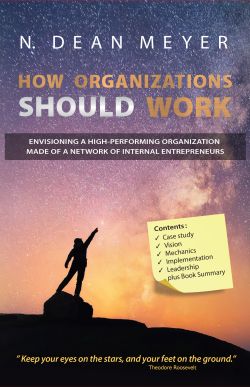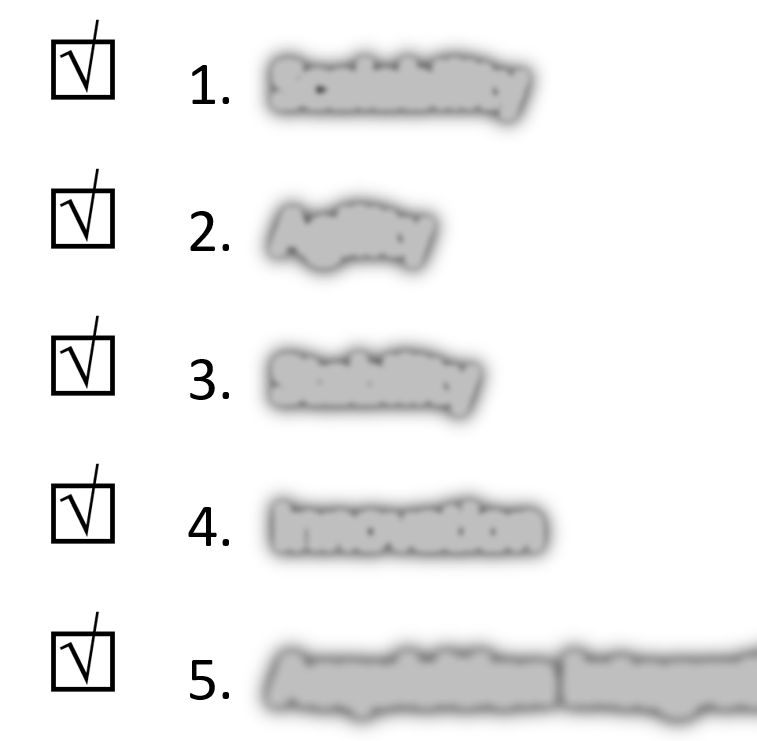| Excerpt from www.NDMA.COM, © 2025 N. Dean Meyer and Associates Inc.
Organizational Excellence Self-assessment for Executives
the ten most challenging hallmarks of a great organizational design
by N. Dean Meyer
Transformational leaders truly care about their organization's design — enough to put time and thought into it. They work "on the machine" (not just "in the machine"). They create the legacy of a high-performing organization that prospers long after they've moved on. If you're a transformational leader (or advise transformational leaders), the framework below may be useful. In just 10 words (or phrases), it summarizes the hallmarks (indicators/characteristics) of excellence in organizational design. Use this list to assess an organization's need for transformation (beyond just marginal continuous improvements in the current organizational operating model). If transformation is needed, use this list to explain to others why change is needed, and what can be expected of the end-state organization (i.e., "begin with the end in mind" [Covey]). The list can also be used to assess various organizational operating models to decide which has the horsepower to get you where you need to go. PS: After the list, you'll also see a description of an organizational operating model the delivers all 10.
VIDEO version: Organizational Excellence Self-assessment for Executives
Instructions: Consider your organization....
For each of the ten hallmarks, read the definition carefully. Then, think about all that your organization could be, as a visionary, and check the box if the hallmark is both important to your organization and needs work (i.e., if it's worth investing in).
Your organization can grow in size and/or diversification, indefinitely, without any material changes in its organizational operating model.
To prosper in this VUCA world, your organization can rapidly reconfigure its capabilities to address new challenges and opportunities, without any material changes in its organizational operating model.
Organizational changes (instability) is costly, and disrupts an organization's productivity for a period of time. The best way to handle a rapidly changing world is a stable (and agile) organization. A great organization can adapt to changes — including people changing jobs, technology innovations, and new methods — without any material changes in its organizational operating model.
Innovation is not constrained to a small group ("skunk-works" or R&D group), which creates a bottleneck for innovation, deprives everyone else of growth opportunities, and wastes so much talent. Instead, innovation is everywhere, in both externally facing products, and in every function (engineering, marketing, logistics, customer service, IT, HR, etc.). Innovation occurs at two levels: 1) innovation in the way each group operates (its skills, tools, methods, and processes); and 2) in its deliverables (results, products/services), with innovations that contribute to enterprise strategies.
Once the deal is done, acquisition integration occurs quickly (months, not years), and achieves all the promised two-way synergies — the acquired business (e.g., product line) benefits from the depth of capabilities (all support services) throughout the enterprise; and the entire enterprise benefits from the acquired capabilities (its talent and support services). (Examples of support services include sales, marketing, engineering, manufacturing, logistics, customer service, and all the usual administrative services.) And now, consider what it takes to be an "employer of choice" — to attract, inspire, and retain top talent without necessarily paying top compensation....
Groups are accountable for results (not just tasks, processes, competencies, etc.). Boundaries are clear. Across the organization, there are no overlapping accountabilities for functions (no internal competition and territorial battles) and there are no gaps (missing capabilities). And accountabilities are documented in a way that's future proof -- not just today's work, but any deliverables now and into the future that meet certain criteria. This gives every group the opportunity to grow and innovate, without the need to redefine accountabilities or change the organization chart.
There's a lot more to teamwork than good interpersonal relations (trust, communications, etc.). Cross-boundary teams form dynamically (not fixed processes, except where appropriate). Teams form laterally (not requiring people to work up and back down the hierarchy). For every project/service, one group is accountable for the entire deliverable. Others on the team are clear about their individual accountabilities for sub-deliverables (results, not functions/tasks/processes). Priorities are aligned such that all team members have time to contribute expected results. Through teamwork, the entire organization is aligned with customers' needs, because customer-facing functions have the whole organization supporting them. It's also aligned with strategic initiatives and operational imperatives.
High levels of individual performance require specialization. Specialists always outperform generalists in their field of study. In fact, specialization is the very reason organizations exist; an organization of generalists performs no better than an equal number of individuals. As long as it's good at teamwork, the more an organization permits specialization, the greater its potential performance. Consolidation of shared services optimizes specialization; there's no need for siloed business units or decentralization (e.g., self-sufficient business units, country managers), which reduce specialization, as long as cross-boundary teamwork is effective.
Empowerment means that authorities and accountabilities match. If the organizational design separates authorities from accountabilities, then (using black-and-white language to make the point) the group with authorities becomes an unconstrained tyrant (no checks and balances); while the group with accountabilities cannot get their job done and becomes a scapegoat when the decisions of the group with authority fail. A healthy organizational design systematically matches authorities and accountabilities. This is so critical that I call it "the Golden Rule" of organizational design.
Employee engagement depends on more than just a great boss and a good compensation plan. It's founded on a supportive and inspiring work environment. Expectations are feasible, not unreasonable. The culture manifests the behaviors that constitute ethics, integrity, interpersonal relations, customer focus, cooperation, and more. Metrics are controllable and fair. Everybody has growth opportunities. And critically important, everybody feels a sense of purpose. Purpose means using one's unique talents to do something hard (that they'll be proud of) and that has value to others.
If you checked any one of these hallmarks, an investment in organizational change may be warranted. But if you checked more than one, here's some good news: That doesn't make your to-do list any longer. Here's why.... It's not wise to work directly on these 10 things; that would be working on symptoms rather than root causes. An organization's performance on all these metrics is the product of its deeper organizational operating model. And there is one organizational design that delivers all ten hallmarks of excellence. What is that design? Imagine an organization where every box on the organization chart is defined as a business within a business. Jobs are defined by what they "sell" (whether or not money changes hands), not roles in processes, responsibilities for tasks, vague "functions," or competencies. Each group knows what business it's in. It knows its products/services. It knows whom its customers are (be they external or other groups within the organization, or both). Lines of business are laid out on the organization chart based on principles, to ensure no gaps and no overlaps, to avoid conflicts of interests and impossible jobs, and to maximize professional synergies. For any project or service, cross-boundary teams form dynamically, with just the right people for each unique challenge, a single point of accountability for the whole deliverable, and clear accountabilities among team members for sub-deliverables (products/services). How? For every deliverable, there's just one group that's in the business of "selling" that product/service. Call them the "prime contractor." The first job of a prime contractor is arranging subcontracts with other groups for needed components and support services. And those subcontractors can, in turn, "buy" help from other groups. Now, go on to imagine that one group is fully accountable for the profit/loss of products/services sold to external customers. Let's call them "brand managers." Everything else is a shared service. Brand managers have no staff. Since every group is entrepreneurial and customer focused, they're eager to deliver their products/services to the brand managers (as well as everybody else). Brand managers "buy" sales, marketing, engineering, manufacturing, logistics, customer service, and all the usual administrative services. Consider how this organizational design satisfies all the hallmarks of organizational excellence:
Consider a facilitated workshop for your leadership team to assess and discuss the ten hallmarks, come to consensus on the need for change (be it incremental or transformation), and agree on the direction of the change -- the business-within-a-business organization. Resources for transformational leaders: Vision: the business-within-a-business paradigm.... Implementation: the five organizational systems that define the ecosystem in which we work.... Resource-governance processes.... Strategy: How to formulate an organizational transformation plan.... Private consultation with Dean Meyer....
|



